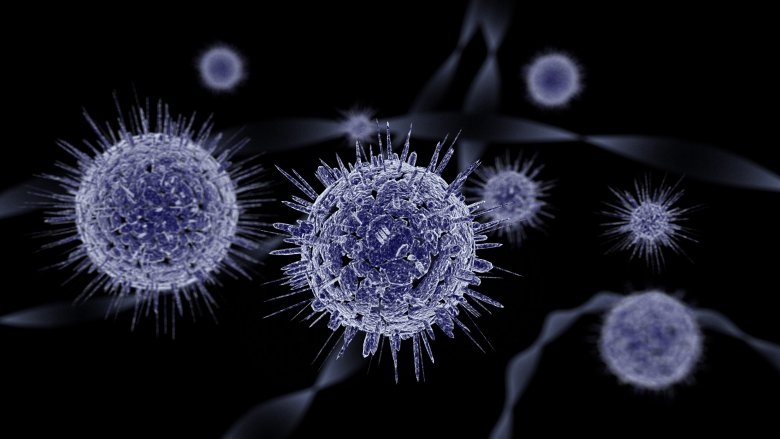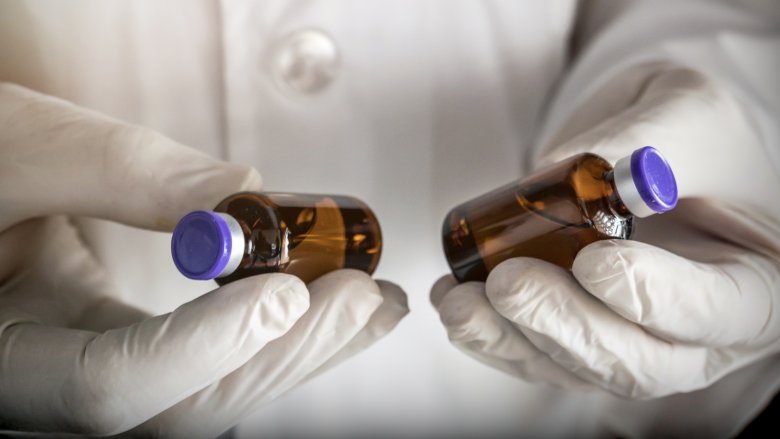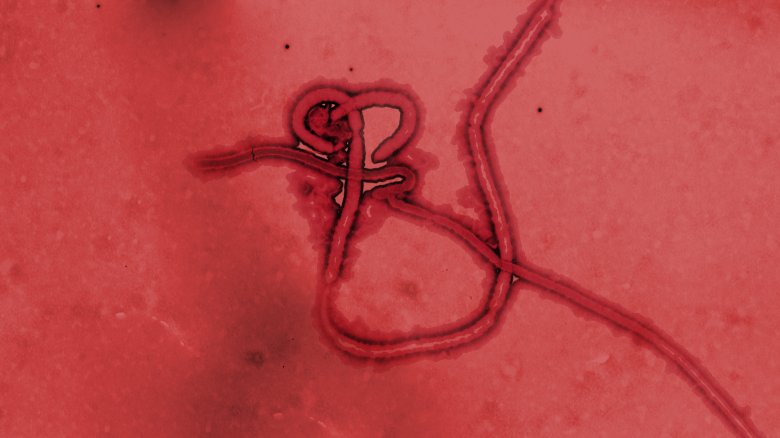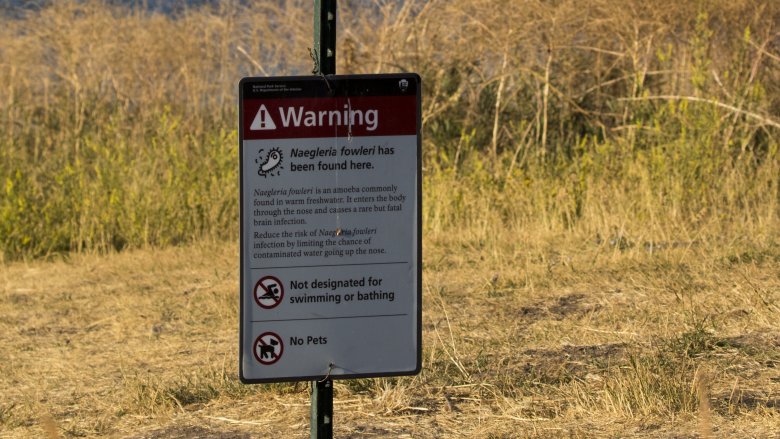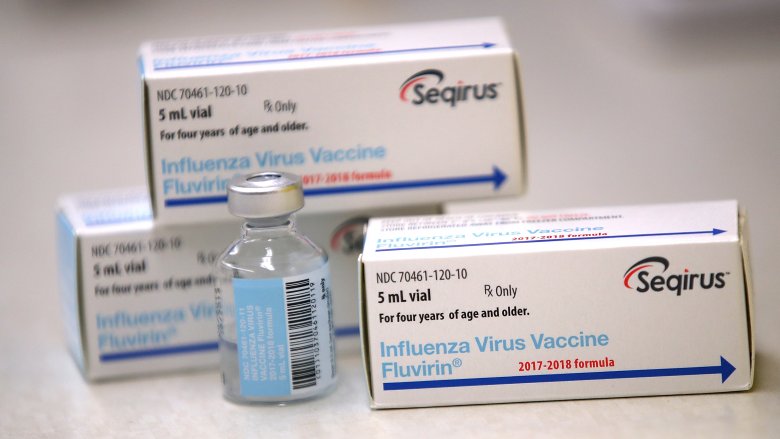Terrifying Facts About The Deadliest Diseases In The World
Westerners like to think we live in a world of relative safety. And we do. Relatively. We also really, really like to pretend that terrible diseases will never come for us because terrible diseases are only really a problem in Matt Damon movies or in the Before Time, when vaccines and antibiotics and antivirals and the CDC didn't exist yet.
It's certainly true that awful diseases like smallpox and bubonic plague don't haunt our communities the way they once did, but it's also true that diseases are sneaky, mutable, and bent on killing someone, somewhere, sometime. They aren't always where you can see them, either. They hide in healthy-looking people, in invisible microbes lurking in public swimming areas, and in cows. So if you want to make sure that you and/or the people you love won't become victims of one of the world's most deadly diseases, you should keep reading. Or, maybe just permanently lock yourself in your house and mail order everything.
Don't worry, the Russians are keeping their smallpox sample very safe
Smallpox wiped out 300 million people, and that was just in the 20th century. Smallpox has had a long and fruitful career of killing people in the most miserable way possible that goes back at least a couple thousand years. According to the BBC, the Egyptian pharaoh Ramses V was history's first known smallpox victim — the telltale pustules can be seen all over his mummified corpse.
We don't worry about smallpox today because the vaccine pretty much eliminated it. The last "natural case" of smallpox happened in 1977, and today the virus only exists in a couple laboratories.
The two World Health Organization-approved labs that still hold smallpox are in Atlanta and Koltsovo, Russia. Both labs were supposed to destroy their stock, thus ridding the world of the pestilence for ever and ever. But in 2001 the U.S. just decided it was going to hang on to some virus, just in case. Um, "just in case" what, exactly?
Smallpox vaccination is no longer routine, which means we're all pretty much doomed if the virus ever escapes those laboratories. In 1992, a Soviet defector told Western intelligence the USSR was using its smallpox to develop a biological weapon. There's also a high probability that disgruntled or unemployed scientists sold some of it to rogue states, so there's that. Oh and North Korea might have some, too. Time to renew your Amazon Prime account.
Here be bubonic plague
Bubonic plague is a disease of the Middle Ages. When we read stories about bubonic plague, we say things like "Thank god we don't have to worry about that anymore!" And then we go camping in our national parks and give breadcrumbs to chipmunks because ignorance is a beautiful thing.
If you ever needed a reason not to feed the adorable chipmunks, here it is. Bubonic plague did not die out during the Middle Ages, and it is no longer confined to the old world. Rats carried plague to the mainland U.S. on ships in the early 20th century. From there, it spread throughout the western United States, mostly in the southwest but also as far north as Washington.
According to the National Park Service, the fleas that carry bubonic plague can be found on squirrels, chipmunks, wood rats, and prairie dogs. Oh, and also your cat can get plague from catching and eating any of the above, and then can give the pneumonic version to you when she/he coughs or sneezes. How awesome is that?
The good news is that plague is rare (between 1 and 17 cases in the United States each year) and is treatable with antibiotics, although the death rate is still 11 percent (50 percent for the pneumonic version). The best way to make sure you don't get plague is to just stay out of national parks in the summer, or maybe just don't feed the chipmunks and keep your cat inside.
Anthrax is practically immortal
The good news is outbreaks of flu or norovirus will sweep through a community, mostly not kill anyone, and then die out within a few weeks. During those times, savvy sickness-avoiders can carry packs of sanitizing wipes around and use them to open doors or wear full-face respirators if they don't mind looking ridiculous. (By the way, hand sanitizer doesn't kill norovirus.) Some viruses will linger for a few days or even a few weeks, but diligence can get you through those times relatively unscathed.
And then there are the more resilient disease-causing bugs, like anthrax, which you may remember from such terrorist attacks as the anonymous spore-containing letters sent to the media and Congress shortly after the attacks on September 11. Anthrax can kill you in a bunch of different fun and interesting ways, including cutaneously, which has a 20 percent chance of killing you, or gastrointestinally, which has a 25 to 75 percent chance of killing you, or via inhalation, which has a whopping 80 percent mortality rate.
What's really terrifying about anthrax is how hardy it is. According to the Journal Sentinel, it can survive in frozen soil for decades and oh guess what, our climate is warming up. Which means that dead, anthrax-infected cattle that were buried in the permafrost will still be able to infect humans and animals up to 105 years later. Plus, birds can poop anthrax, so there's that.
Rabies can incubate for years
And because anthrax in melting permafrost and bubonic plague in cats is not terrifying enough, one of the world's deadliest diseases can linger in a human body for years, sometimes decades, before finally deciding to get on with the work of painful, horrible death.
In 2008 the CDC documented a case of rabies in a 10-year-old girl who was infected in Hong Kong but didn't develop symptoms until at least four and half years (possibly even as long as six years) later, when she was living in Australia. You're probably thinking, "That sounds suspicious, how do they know she didn't get exposed in Australia?" Because the CDC can trace the phylogenetic origins of the virus, which identified the specific virus that killed the girl as being of Chinese origins. And then they decided to tell everyone what they found so that we can live our lives in irrational fear.
So now you can count back to the last time an animal bit you and absolutely not be comforted if it happened within the last six years. And you won't want to read about this other case, in which a 48-year-old man was diagnosed with rabies 25 years after he was bitten by a dog in Goa, India. You might have to wait until you're middle-aged before you can stop worrying about the bat that was flying around in your bedroom 10 years ago or the stray cat that scratched you back in 1997. You're welcome.
Wine, candles, and Ebola
Ebola liquefies your tissues and then you bleed to death out of every orifice in your body. But it's not all bad, maybe you won't actually die. On average, one out of two people will survive the whole liquefied flesh and hemorrhaging thing and then go back to their homes illness-free. Except now they carry Ebola and guess what, it's an STI.
So male survivors can go home looking perfectly healthy and give their partners Ebola just after that "welcome home" candlelight dinner. According to the World Health Organization, Ebola can potentially be sexually transmitted for up to 82 days after the onset of symptoms, but just to be extra cautious WHO likes to advise survivors to avoid unprotected sex for up to a year, unless said survivors are willing to be tested once a month until two tests in a row come back negative.
WHO seems to be saying condoms can prevent the spread of Ebola, but that's sort of like putting a door between yourself and a guy with a gun — sure, the door will probably stop the bullet from hitting you, but maybe not, and do you really want to take that chance? And that's not even a great analogy because death by bullet is like a warm day at the beach compared to liquefied tissue and hemorrhaging out of every orifice. But never underestimate the human capacity for doing stupid things in the name of lust.
Getting water up your nose sucks, and also you might die
No summer activity is as beloved as swimming in freshwater lakes. We love to think that as long as we put our kids in life jackets, nothing deadly can touch them while they're splashing around in the shallows. Unfortunately, no one is safe, anywhere, ever, because now we have to worry about death-bringing single-celled organisms on top of bubonic chipmunks and immortal anthrax.
Lurking in warm freshwater lakes on every continent except Antarctica is a tiny creature that under a microscope literally looks like the most terrifying circus clown of all time — it's called Naegleria fowleri and it eats water-dwelling bacteria and also human brains, which is what earned it the adorable nickname "brain-eating amoeba." But don't worry, N. fowleri can't eat your brain unless it's in water that goes up your nose, which is only something that happens every time you go swimming.
It may comfort you to know that infection is pretty uncommon (although it does still happen). In fact, you're more likely to die in a car accident on your way to the lake than you are to have your brains eaten by an amoeba. But you might want to get used to the idea that you're sharing your favorite swimming hole with a microscopic agent of death — N. fowleri is so prolific that lakes don't routinely test for it because it's pretty much everywhere and there isn't much to do about if if they do find it. The moral of this story: wear nose plugs, or just stay plan your next lakeside camping trip for somewhere above the Arctic circle.
Insomnia sucks, and also you might die
The next time you can't sleep, try counting sheep. If you still can't sleep, try counting prions instead because maybe you have a 100 percent fatal inherited brain disease that often has insomnia as its first symptom. Because you totally needed something else to keep you up at night.
Fatal familial insomnia is a prion disease related to mad cow disease. While some prion diseases are acquired, fatal familial insomnia is genetic, which means you're born with a switch in your brain that lets you know it's time to die sometime in your 40s and 50s by interfering with your sleep. According to Gizmodo, once symptoms set in, sufferers have between 12 and 18 months to live.
Despite the name, fatal familial insomnia doesn't just kill you with sleep deprivation. It also causes hallucinations, muscle twitches, and dementia that gradually progresses to an inability to walk or talk, and also an inability to sleep at all, ever, which frankly makes death by Ebola sound pretty easy.
The good news is fatal familial insomnia is extremely rare, affecting around 40 families worldwide, so if you've never had a family member die from the disorder, it's extremely unlikely that you have to worry about it. Tonight, when you're having trouble sleeping, try to remind yourself that it's probably just because you're worried about the stuff you read about fatal familial insomnia. Probably.
Speaking of prions
But wait, there's more. If you're not born with the gene for a fatal prion disease, you can still acquire a prion disease the old fashioned way — just eat some tainted meat, and you too can die from a horrible, degenerative brain disease. Yay.
People don't actually get mad cow disease, they get a human variant called Creutzfeldt-Jakob disease, but let's just call it mad person disease because it's a lot easier than trying to pronounce "Creutzfeldt." You can get mad person disease from eating meat infected with the abnormal prions that cause sickness in cattle. And just in case you think you can thoroughly cook your hamburgers and burn away all that disease, according to ThoughtCo, the temperatures necessary to inactivate the abnormal prions are so high that you'd make your food inedible, so that's not really an option for most people except those who enjoy hockey-pucks with a side of ashes.
The good news is the high-risk parts of the cow are the brain and spinal cord, and (in the United States) it isn't legal to use these parts either as human food or as animal food, so the chances are pretty good you won't get sick from eating home-grown beef. But you could also spontaneously develop Creutzfeldt-Jakob disease, or inherit it from someone in your family, so just in case you were starting to feel safe, sorry about that.
Let's recreate the virus that wiped out millions of people
Seasonal influenza is a nuisance, but at least it doesn't kill anyone. Except that it kills a lot of people. According to the CDC, annual flu-associated deaths in the U.S. alone are between 12,000 and 79,000. If you needed a reason to get vaccinated, there it is.
While even 12,000 deaths sounds like a crazy-high number, that's nothing compared to the 20 million to 40 million people who died from the Spanish flu in 1918. But we like to tell ourselves that won't happen again, because, you know, progress.
The Spanish flu was dangerous because people had little natural immunity to it. But never fear, the CDC has recreated a live version of the Spanish flu virus for purely educational purposes, and it's being kept under super-tight security so no one can ever use it as a biological weapon. Later on, the CDC plans to give some of the recreated virus to Russia so it can be studied there, too. (Just kidding.)
After comparing the 1918 flu strain to modern avian strains, scientists believe they share similar mutations that allow them to jump from birds to humans. From there, scientists concluded the 1918 flu was an avian strain that had also acquired a mutation allowing it to move easily within human populations. So really, all it will take for a brand new worldwide pandemic is a similar mutation. How's that for terrifying?
Only people with brains have to worry about Alzheimer's
Everyone hopes to live to a ripe old age. Long life is a big accomplishment, and it has perks — you probably get to see your kids grow up, graduate college, marry, and have families of their own, and you might even get to see your grandchildren do the same thing. You get to retire and spend your golden years pursing your hobbies and enjoying the company of friends and family. If Alzheimer's doesn't get you.
But wait, Alzheimer's is a genetic disease. Isn't it? Actually, according to Newsweek, "anyone with a brain is at risk for developing Alzheimer's," which means pretty much everyone you know with maybe one or two exceptions. The greatest risk factor for Alzheimer's disease is advanced age. And here's something else: Alzheimer's disease is also 100 percent fatal. There are no treatments that effectively halt its progression, and there's no way to reverse it. By 2050, it's estimated that 16 million Americans will have Alzheimer's disease, which means 16 million dead at an approximate cost of $1.2 trillion. Death usually comes in the form of a secondary infection, though the disease also has the potential to progress so far that it inhibits the patient's ability to breathe.
So if you do manage to get through your entire life without dying from Ebola, rabies, anthrax, plague, smallpox, some insidious prion disease, or something a lot more common like cancer, you have forgetting everyone and everything you ever loved to look forward to instead. You really can't win.
Not every deadly disease has symptoms
Some people worry a lot about getting sick, and high on the list of illnesses that cause the most anxiety are common but deadly diseases like cancer and Alzheimer's. What we don't seem to worry about as much is another even more common and equally deadly disease — heart disease, which is actually the leading cause of death for American women. In 2013, just under 300,000 women died from heart disease, which is 25 percent of all female deaths across all age groups.
Just in case that number isn't scary enough, here's another one: According to the CDC, 64 percent of women who die suddenly from heart disease don't have any symptoms before death. So you could be walking around right now, feeling extra-super healthy, and by lunchtime you could be keeling over into your Caesar salad, never to eat Caesar salad again. Because you'll be dead.
So what to do? First, lay off the Caesar salad because the dressing is full of fat. Second, find out what your blood pressure is and monitor it often. Third, don't smoke. The three biggest risk factors for heart disease are high cholesterol, high blood pressure, and smoking, so eliminating those three risk factors is the best way to avoid keeling over into your Caesar salad. And stay out of warm freshwater lakes, too, because why take chances?
